You’ll find Walnut Canyon National Monument quietly compelling, with well-preserved Sinagua cliff dwellings and dramatic canyon views that reward careful exploration. This guide will help you plan the trip, choose between the Island and Rim trails, and follow best practices to protect fragile ruins. Keep going to learn the practical details—hours, access, safety tips, and nearby stays—that make a visit smoother and more meaningful.
Overview and Historical Significance of Walnut Canyon
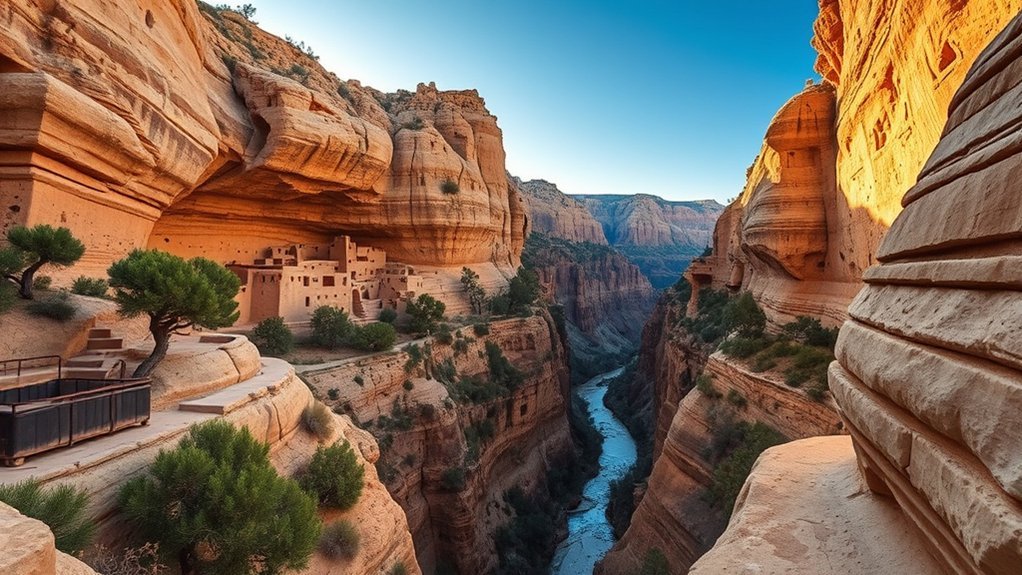
Because Walnut Canyon preserves more than 300 Sinagua cliff dwellings built between 1125 and 1250 CE, you can see firsthand a concentrated record of prehistoric life in the high desert: the canyon’s stone-and-mortar rooms, ceremonial spaces, and surrounding terraces reveal distinctive architectural styles, innovative agricultural practices, and long-distance trade networks that sustained the community. When you visit Walnut Canyon National Monument, you’ll encounter an archaeological site that’s both pristine and instructive, illustrating how the Sinagua people adapted to a harsh environment. This place preserves historical and cultural heritage tied to 13 modern tribal communities, so you’ll appreciate living connections as well as material remains. Respectful observation will deepen your understanding of the region’s enduring human story.
Getting There and Parking Information
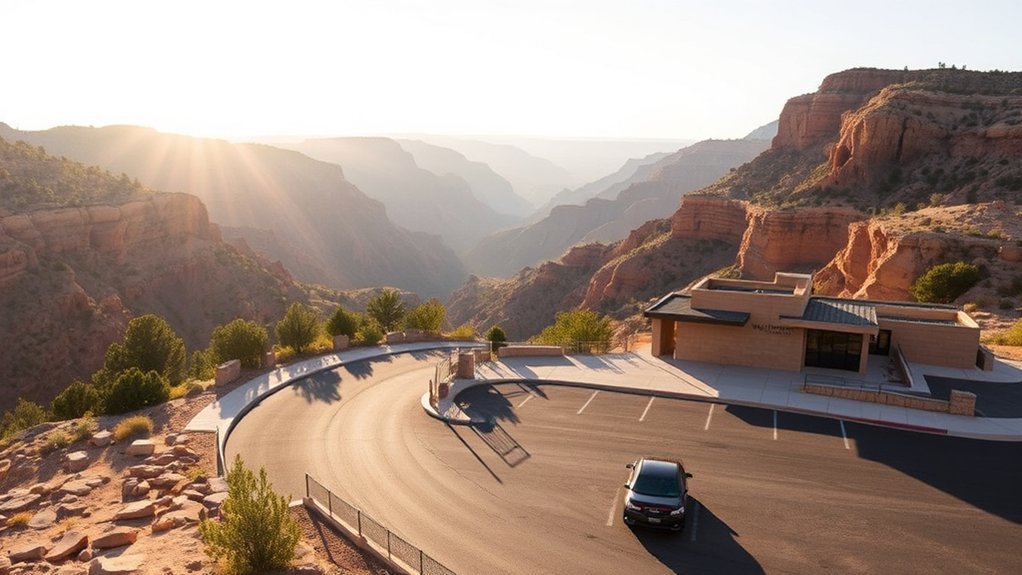
If you’re coming from Flagstaff, head east on I‑40 for about 10 miles and take exit 204 for the Walnut Canyon National Monument turnoff; the visitor center sits just off the exit and offers a large parking lot where you can leave your vehicle and begin your visit. The Walnut Canyon area is easily accessible from the interstate, and signage guides you to the monument. Admission is $25 per vehicle (valid seven days) and the America the Beautiful Pass is accepted. Note dogs aren’t allowed on trails or in the visitor center. Park in the designated parking lot, then check trail conditions before starting. You’ll find short walks nearby and clear directions to the Island Trail.
| Feature | Details |
|---|---|
| Access | I‑40 Exit 204 |
| Parking | Large parking lot |
Visitor Center: Hours, Services, and Accessibility
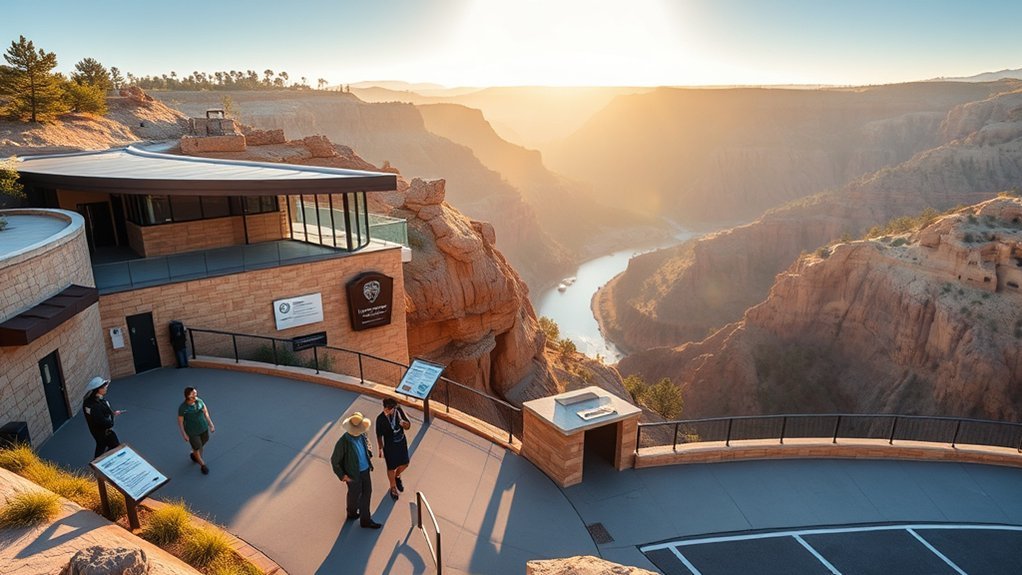
You’ll find the Walnut Canyon Visitor Center open daily from 9:00 am to 5:00 pm (closed Christmas), where rangers provide essential information and exhibits about the Sinagua cliff dwellings. The center includes a gift shop, restrooms, and seasonal water for hikers, and it’s the starting point for the Rim and Island Trails. Paved paths, interpretive signage, parking with a $25 per-vehicle seven-day admission, and clear access rules (no dogs in the center or on trails) help guarantee accessibility and a smooth visit.
Visitor Center Hours
The Visitor Center is open daily from 9:00 am to 5:00 pm (closed only on Christmas Day and New Year’s Day) and serves as your starting point for hikes, exhibits, the gift shop, and restrooms. You’ll find the Walnut Canyon Visitor Center staffed to answer questions about visitor center hours, the hiking trails, and safe access to Island Trail. Note the last access to the Island Trail is by 3:00 pm so you can return before closing. The facility is accessible, with paved paths and safety features.
- Check visitor center hours on arrival to plan hikes.
- Grab water for warmer months before starting trails.
- Confirm Island Trail access cutoff at 3:00 pm.
- Use paved routes for easier accessibility.
Services and Amenities
1 clear stop at the Walnut Canyon Visitor Center makes planning your visit easier: it’s open daily from 9:00 am to 5:00 pm (closed only on Christmas Day), offers educational exhibits about the canyon’s history and ecology, and provides restrooms, a gift shop, and water stations for hikers. You’ll find the visitor center’s services focused on preparing you for the trails and interpreting the cliff dwellings through displays and large windows overlooking the canyon. Staff can answer questions, suggest trail options, and supply maps. Amenities are practical and seasonal—water stations are emphasized during warm months. Note that parking is available for a $25 fee per vehicle, covering up to seven consecutive days, so plan your arrival accordingly.
Accessibility and Access
Although the visitor center opens at 9:00 am and closes at 5:00 pm daily (except Christmas and New Year’s Day), plan to stop there first to pick up maps, ask staff about trail conditions, and use restrooms or water stations before you head into the canyon. The visitor center offers educational exhibits and a large parking lot for easy access. For accessibility, both the Rim and Island trails are paved, but the Island Trail’s many stairs may pose mobility issues. Interpretive signs along the trails explain Sinagua history and the cliff dwellings. Before you go, consider these points:
- Use the parking lot near the visitor center for closest access.
- Ask staff about ramped or alternative routes.
- Bring water from the center in warm months.
- Expect stairs on the Island Trail; plan accordingly.
Island Trail: Route, Difficulty, and What to See
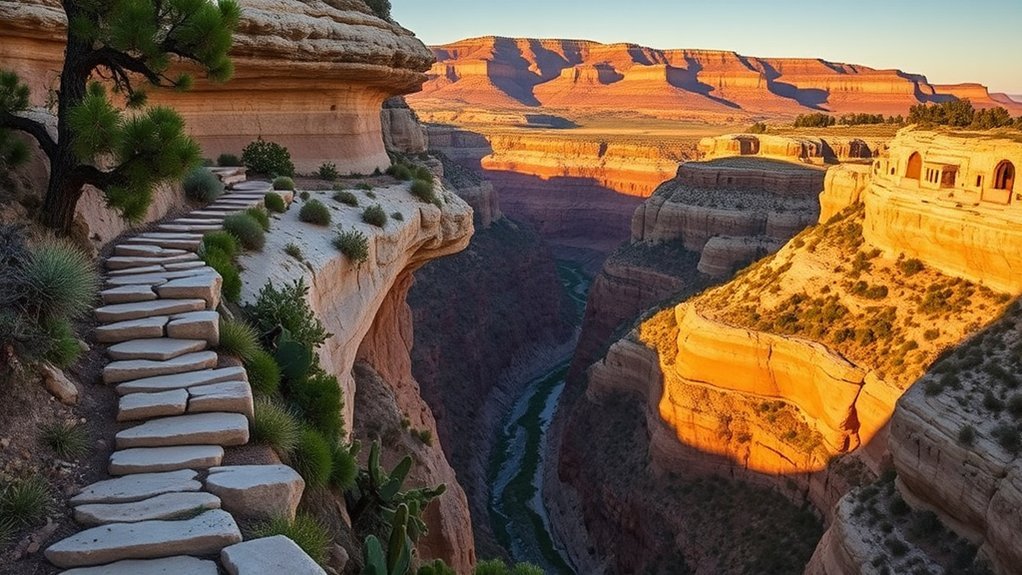
Take the Island Trail when you want a compact but rewarding hike that drops about 370 feet into a narrow canyon and climbs back out via more than 200 stairs; it’s a paved, roughly 1-mile loop that most visitors complete in about an hour at a leisurely pace. You’ll encounter a series of 25 ancient dwellings built by the Sinagua, each explained with clear signage that connects you to the site’s history. Trail difficulty is moderate to strenuous because of the steep ascent — good fitness helps. The paved surface improves footing, but expect significant elevation change and use caution on stairs. Plan your hike so you start early enough for the last access by 3:00 pm to guarantee a safe return.
Rim Trail: Highlights and Scenic Overlooks
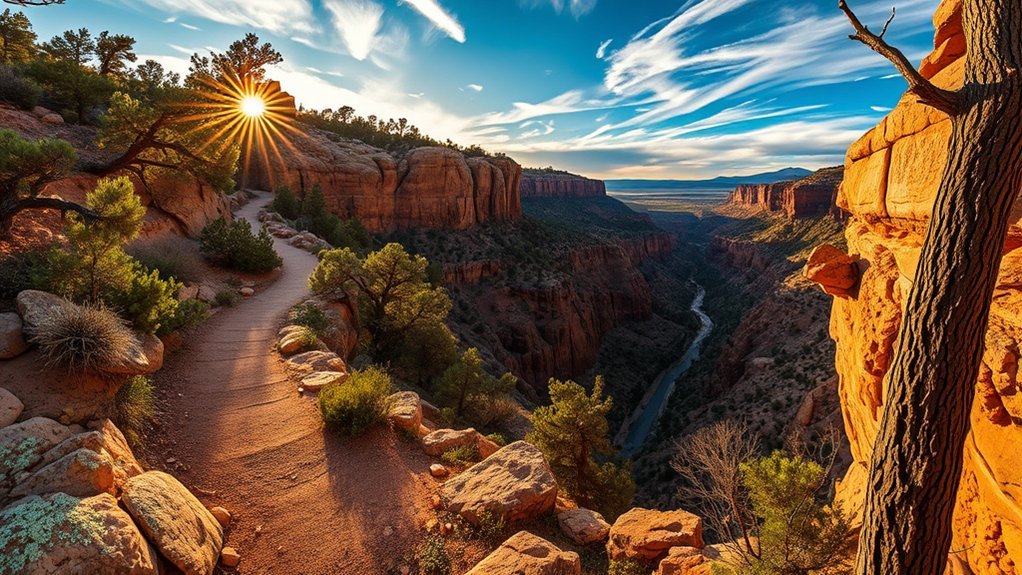
From the Rim Trail you’ll get sweeping canyon rim views that frame Walnut Canyon’s cliffs and reconstructed dwellings. Interpretive overlooks along the paved, 0.7-mile loop explain the Sinagua history and local plants and animals as you move between benches and scenic points. It’s an accessible, informative introduction to the canyon that sets up further exploration.
Canyon Rim Views
A short, easy walk along the 0.7-mile Rim Trail rewards you with sweeping panoramic views of Walnut Canyon and the ancient cliff dwellings carved into its walls. You’ll follow a flat, paved path with benches that invite pauses to study the canyon walls and photograph the ruins from multiple scenic overlooks. The trail ends at a final overlook that frames geology and human history together.
- Watch for interpretive signs about local flora and Sinagua agriculture.
- Use benches to rest and compose photographs of the cliff dwellings.
- Stay on the paved path to protect fragile soils and viewpoints.
- Arrive during morning or late afternoon light for best panoramic views.
Interpretive Overlooks
The Rim Trail’s interpretive overlooks give you clear, accessible information about Walnut Canyon’s geology and the Sinagua people, with signs placed at strategic viewpoints that explain rock formations, ancient farming practices, and cliff-dwelling architecture. As you follow the paved 0.7-mile loop, interpretive overlooks punctuate panoramic canyon views and the ancient cliff dwellings below, offering concise panels that link landscape to human adaptation. Benches let you pause and absorb perspectives on the partially rebuilt pueblo and construction techniques used by the Sinagua. These stops emphasize cultural heritage and ecological context, enhancing your visitor experience without demanding strenuous effort. The accessible design guarantees families and visitors with varying abilities can engage directly with the site’s history and natural story.
Rules, Safety, and Protecting Cultural Resources
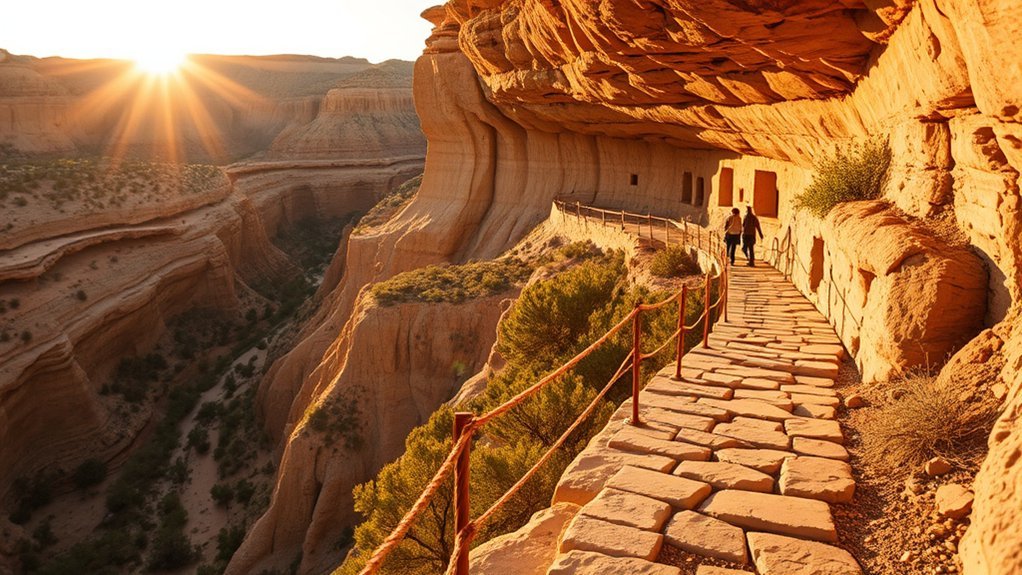
While visiting Walnut Canyon, please stay on designated trails and follow posted rules so you protect fragile terrain, cultural sites, and local wildlife. You’ll respect rules and safety by observing these essentials:
- Don’t go off-trail — off-trail wandering damages fragile terrain and ancient ruins and can bring substantial fines.
- Never enter cliff dwellings — preserving cultural resources means you view, not touch, these irreplaceable structures.
- Leave pets at home — animals aren’t allowed in the Visitor Center or on trails to protect visitors and wildlife.
- Monitor trail conditions and closures — park staff provide updates; ask at the Visitor Center and take breaks at nearly 7,000 feet altitude despite handrails and paved paths.
Wildlife, Plants, and Seasonal Considerations

Because seasons shape what you’ll see here, plan visits with wildlife cycles and plant blooms in mind: spring and early summer bring migrating birds and wildflowers, while cooler fall and winter weather at nearly 7,000 feet can change animal activity and trail conditions quickly. You’ll encounter diverse wildlife—coyotes, mule deer, javelina, occasional bears and mountain lions—so stay alert, maintain distance, and follow posted guidance. Interpretive signage explains the region’s flora and how native plants supported the Sinagua people. Seasonal timing affects visibility and behavior; mornings and evenings are often best for sightings. Respect closures and stay on trails to preserve fragile habitat. Understanding ecological balance helps you minimize impact and supports long‑term protection of plants, animals, and cultural resources.
Tickets, Passes, and Admission Policies

If you’re planning a visit, know that admission is $25 per vehicle and covers up to seven consecutive days—or you can use the America the Beautiful pass for entry at no additional charge. When visiting Walnut Canyon, you’ll handle tickets and fees at the visitor center or via staffed entry; keep your pass or receipt visible. Note hours and restrictions so you don’t lose access.
- Monument hours: open daily 9:00 am–5:00 pm (closed Christmas Day).
- Trail access: last entry to Island Trail is 3:00 pm; trail closes one hour before the monument.
- Pets: not allowed in the Visitor Center or on trails.
- Fees: vehicle admission covers occupants; individual ticketing follows standard park policy.
Nearby Attractions and Where to Stay

Several nearby destinations make Walnut Canyon a great base for exploring northern Arizona. You’ll find Flagstaff just 15 minutes away with hotels, restaurants, and services that make overnight stays easy. For day trips, Sunset Crater’s volcanic trails are about 30 minutes out, while Wupatki National Monument’s ruins sit roughly 45 minutes away. The Grand Canyon National Park is reachable in about 1.5 hours for a full-day visit, and Sedona’s red rocks are an hour distant.
| Attraction | Distance/Notes |
|---|---|
| Flagstaff | 15 minutes — lodging, dining |
| Sunset Crater | 30 minutes — volcanic hikes |
| Wupatki National Monument | 45 minutes — cultural sites |
| Grand Canyon National Park | 1.5 hours — iconic vistas |
Frequently Asked Questions
How Much Time Do You Need at the Walnut Canyon National Monument?
You’ll need about 1.5–2 hours to see the highlights, balancing best visiting times, time management, trail options, family activities, and scenic viewpoints; start Island Trail by 3:00 pm, add 30 minutes for the visitor center.
Is the Walnut Canyon National Monument Worth Visiting?
Absolutely — it’s a hidden gem that sings: you’ll get scenic views, strong historical significance, wildlife spotting, photography opportunities, and rich cultural heritage, so plan a visit and you’ll leave informed, inspired, and respectfully moved.
What Is There to Do at Walnut Canyon National Monument?
You can hike trails to explore ancient dwellings, enjoy scenic views, and go wildlife spotting; you’ll visit the visitor center for exhibits, restrooms, and a gift shop, and follow interpretive signs while hiking responsibly.
How Hard Is the Hike to Walnut Canyon?
It’s moderately to strenuously challenging: hiking difficulty varies by trail, with steep elevation gain and many steps on the Island Trail; trail conditions can be rocky. Scenic viewpoints reward you—hiking tips: pace yourself, drink water, watch altitude.
Conclusion
You’ve walked ancient steps, peered into cliffside rooms, and felt the quiet pulse of the Sinagua people here—so leave with respect and curiosity. Keep exploring the Rim and Island trails, follow park rules, and protect fragile ruins like a guardian of a living museum. Whether you stay nearby or keep moving down the highway, let Walnut Canyon’s stories linger—timeless and vivid, like an old photograph that still manages to take your breath away.

